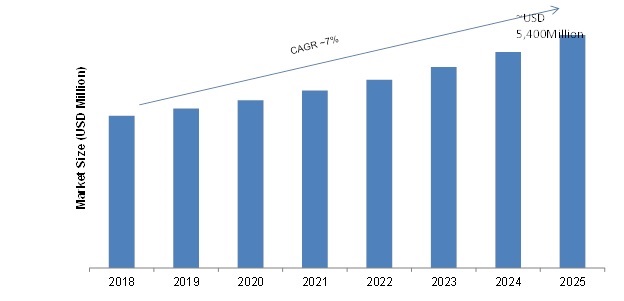P2P Antennas Market Research Report: By Type (Parabolic Antennas, Flat Panel Antennas and Yagi Antennas), Polarization (Single-Polarized Antennas and Dual-Polarized Antennas), Diameter (0.2 Meters to 0.9 Meters, 1.0 Meters to 3.0 Meters and 3.1 Meters to 4.6 Meters), Frequency Range (1.0GHZ to 9.9 GHz, 10.0 GHz to 29.9 GHz and 30.0 GHz to 86.0 GHz), Application (Telecommunication, Commercial, Military and Defense, Satellite and Others) and Region (North America, Europe, Asia-Pacific and the Rest of the World) - Forecast till 2027
ID: MRFR/SEM/8609-HCR | February 2021 | Region: Global | 100 pages
Market Synopsis
Global P2P Antennas Market is estimated to reach USD 5,365.4 Million by 2025, registering a CAGR of 6.8% during the forecast period of 2020–2025.
P2P antennas enable communications between two nodes or endpoints. These antennas broadcast and receive information between various antennas and communication systems by using either time-division multiplexing or frequency division multiplexing for transmitting and receiving the data and maintaining the bidirectional traffic flow. Additionally, these antennas can transmit and receive information from both short-range and long-range distances depending upon the requirements of the user or the industries. P2P antennas provide high-speed communication and are used for carrying voice and data traffic in various bandwidth-intensive applications, while also increasing the efficiency over a large connection distance.
越来越多的国际米兰net penetration among individuals, companies, and industries is one of the major factors increasing the need for P2P antennas. These antennas are easy to install and offer high speed for two-way communication between nodes. These benefits of P2P antennas are boosting the growth of the market. The increasing advancements in technology and the rising demand for high-speed communication systems from the military and defense sector is one of the major factors which is driving the growth of the market. Similarly, these antennas are used for connectivity by corporate organizations, telecom carriers, governments, and other users in various applications.
Segmentation
Global P2P antennas market has been segmented based on Type, Polarization, Diameter, Frequency Range, Application, and Region.
By type, the market has been segmented as parabolic antennas, flat panel antennas, and Yagi antennas.
By polarization, the market has been segmented into single-polarized antennas and dual-polarized antennas.
By diameter, the market has been segmented into 0.2 meters to 0.9 meters, 1.0 meters to 3.0 meters, and 3.1 meters to 4.6 meters
By frequency range, the market has been segmented into 1.0 GHz to 9.9 GHz, 10.0 GHz to 29.9 GHz, and 30.0 GHz to 86.0 GHz
By application, the market has been segmented into telecommunication, commercial, military and defense, satellite, and others
By region, the market has been segmented into North America, Europe, Asia-Pacific, and the rest of the world.
Global P2P Antennas Market, 2018–2025 (USD Million)
Source: MRFR Website
Regional Analysis
The Global P2P antennas market is estimated to grow at a significant rate during the forecast period from 2020 to 2025. The geographic analysis of the P2P antennas market has been conducted for North America (the US, Canada, and Mexico), Europe (the UK, Germany, France, Spain, Italy, and the rest of Europe), Asia-Pacific (China, Japan, India, and the rest of Asia-Pacific), and the rest of the world (the Middle East & Africa and South America).
By region, North America held the largest share for the P2P antennas market in 2019 and is projected to register significant growth during the forecast period. Various factors are driving the growth of the P2P antennas market in North America, such as the presence of the latest technologies and developed infrastructure. Furthermore, the presence of companies such as CommScope, Inc., Cambium Networks, Amphenol Corporation, and others in the region are also fueling the growth of the market. The rising demand for high-speed Internet and the need to manage data traffic in two-way communications is also fueling the market growth in the region. However, Asia-pacific is expected to be the fastest-growing regional market for P2P antennas during the forecast period due to the increasing adoption of the Internet by the industries in government agencies in the region.
Key Players
MRFR recognizes the key players in the global P2P antennas market as CommScope, Inc., (US), Ericsson (Sweden), COMBA Telecom Systems Holdings (Hong Kong), Amphenol Corporation (US), Cambium Networks (US), TONGYU Communication (China), Laird Technologies (US), Radio Frequency Systems (Germany), Rosenberger (Germany), SHENGLU (China), MOBI Antenna Technologies (China), Infinite Electronics International (US), TRANGO Networks LLC. (US), MWAVE Industries (US), and KAVVERI Telecom (India), among others.
The leading players innovate and invest in research & development to present a cost-effective product portfolio. There have been recent mergers & acquisitions among the key players, a strategy that the enterprises leverage to strengthen their reach to the customers.
Intended Audience
- Military & Defense
- Investors and Consultants
- Telecom Industry
- Government Organizations
- Research/Consultancy Firms
- Security & Surveillance
- Manufacturers
- Automotive
Frequently Asked Questions (FAQ) :
The P2P antennas market valuation would reach USD 5,365.4 million by 2025.
The P2P antennas market CAGR would be around 6.8% during the forecast period of 2020 to 2025.
The segments discussed in the P2P antennas market are type, polarization, diameter, frequency range, and application.
North America would take charge of the global P2P antennas market.
The P2P antennas market report has players like COMBA Telecom Systems Holdings (Hong Kong), CommScope, Inc., (US), Ericsson (Sweden), Cambium Networks (US), Amphenol Corporation (US), Laird Technologies (US), TONGYU Communication (China), Rosenberger (Germany), Radio Frequency Systems (Germany), MOBI Antenna Technologies (China), SHENGLU (China), MWAVE Industries (US), TRANGO Networks LLC. (US), Infinite Electronics International (US), and KAVVERI Telecom (India).
